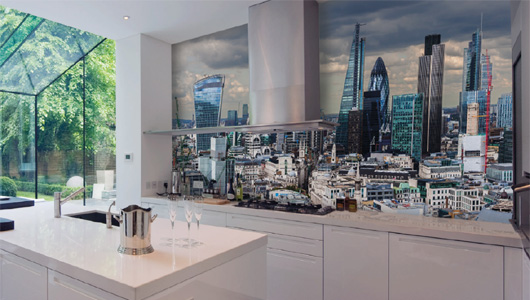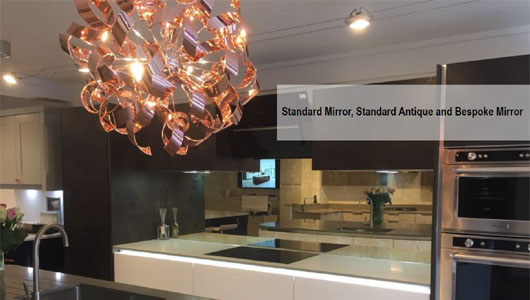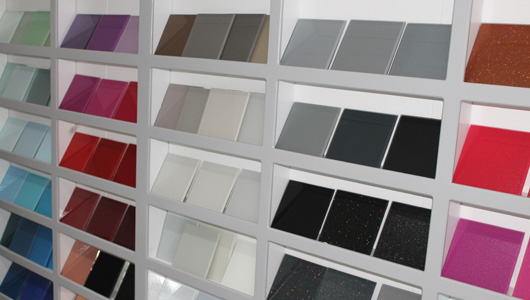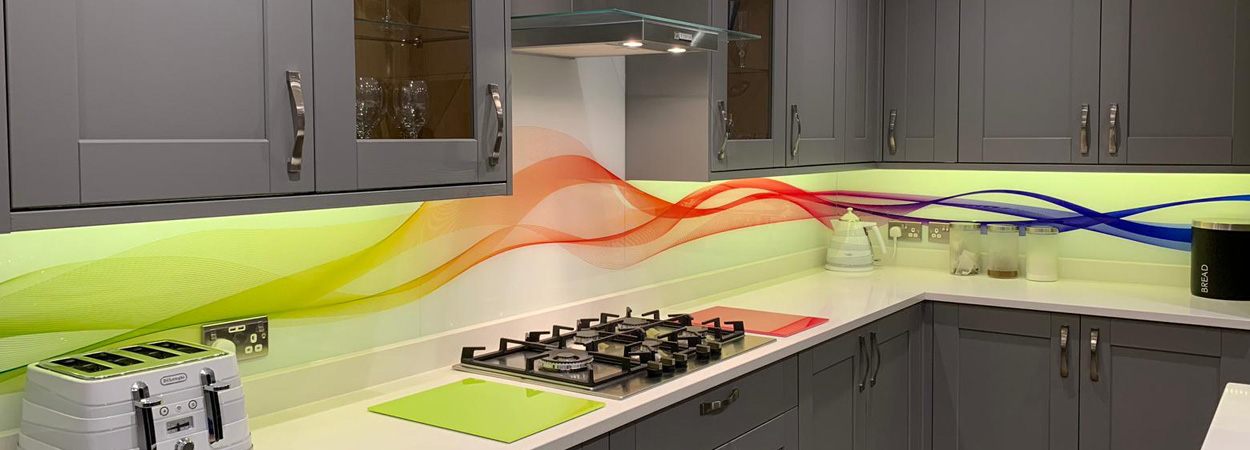
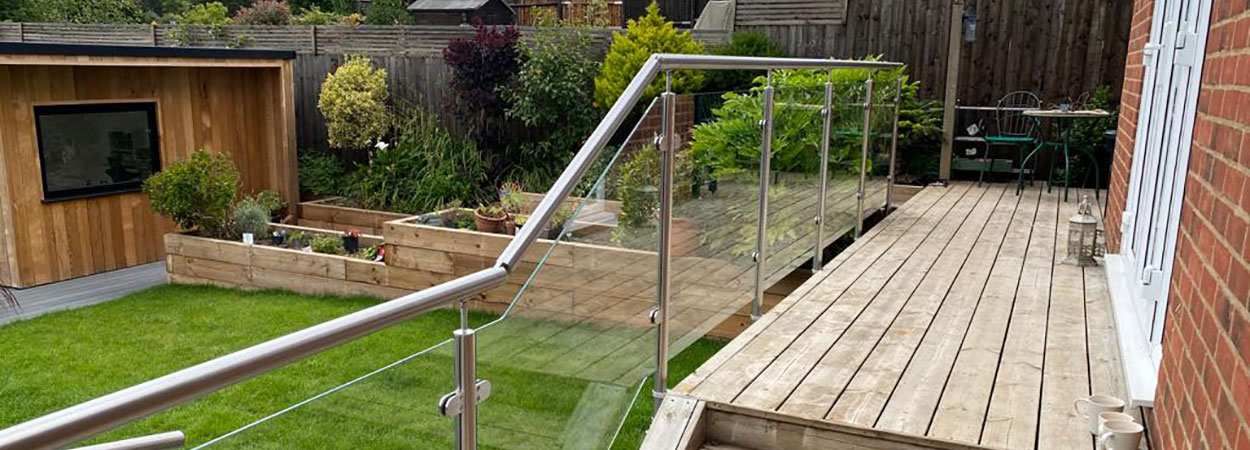
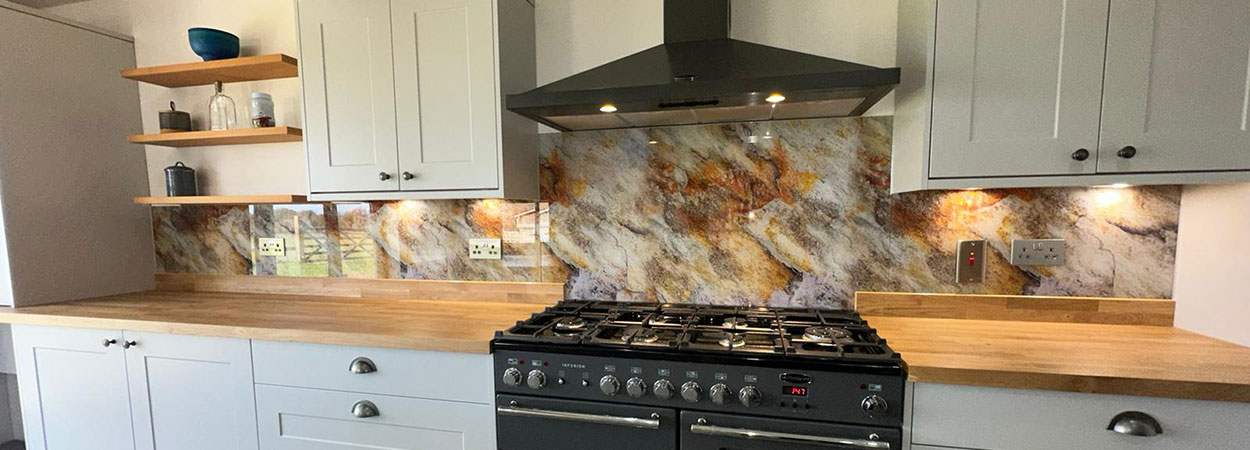
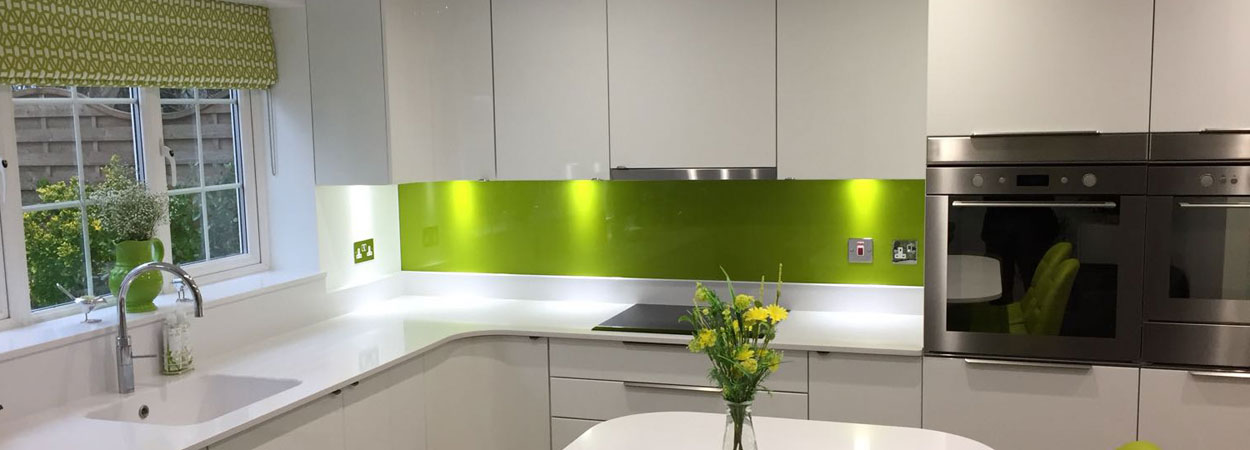
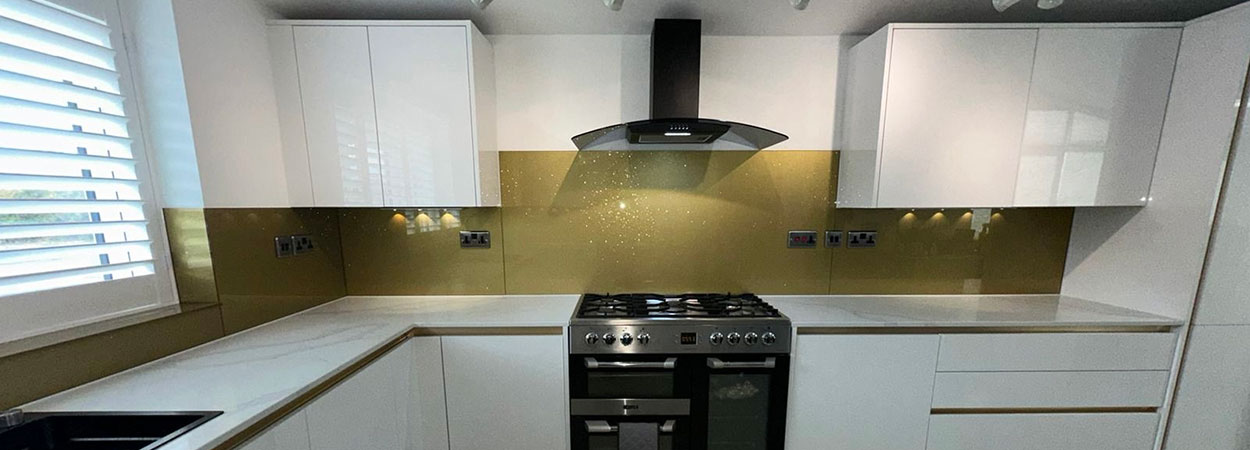
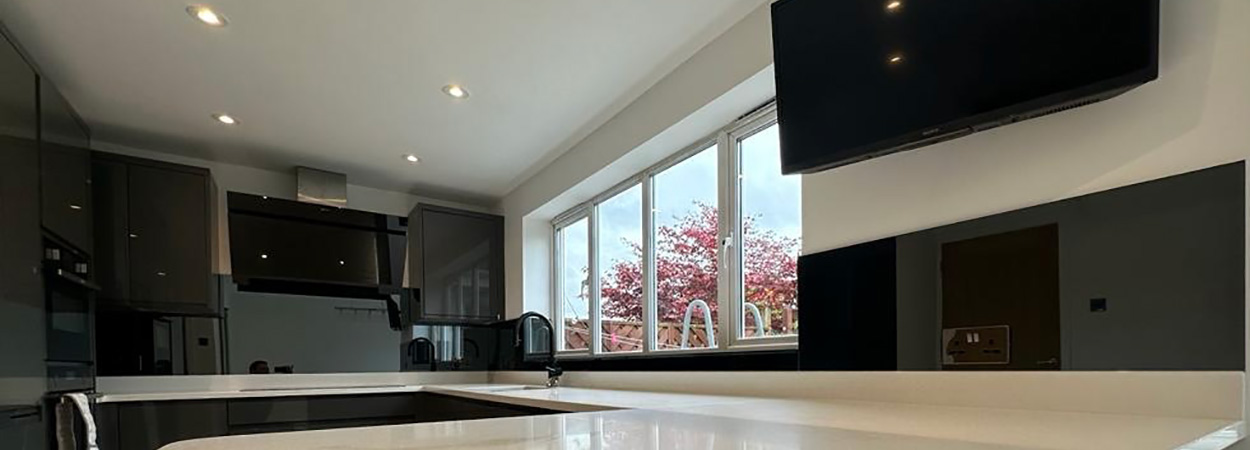


















Glass Splashbacks | Kitchen Splashbacks | Bathroom Splashbacks | Glass Balustrades | Colchester, Essex
Based in Stevenage, Hertfordshire, Splashbacks of Distinction have a real passion for toughened glass in and around the home. We have transformed many properties, both commercial and domestic with our glass splashbacks, for kitchens, bathrooms and living rooms. Our toughened glass balustrades, glass shelving and splashbacks with high resolution images have really caught the imagination of people who demand beauty and functionality in their homes and offices.
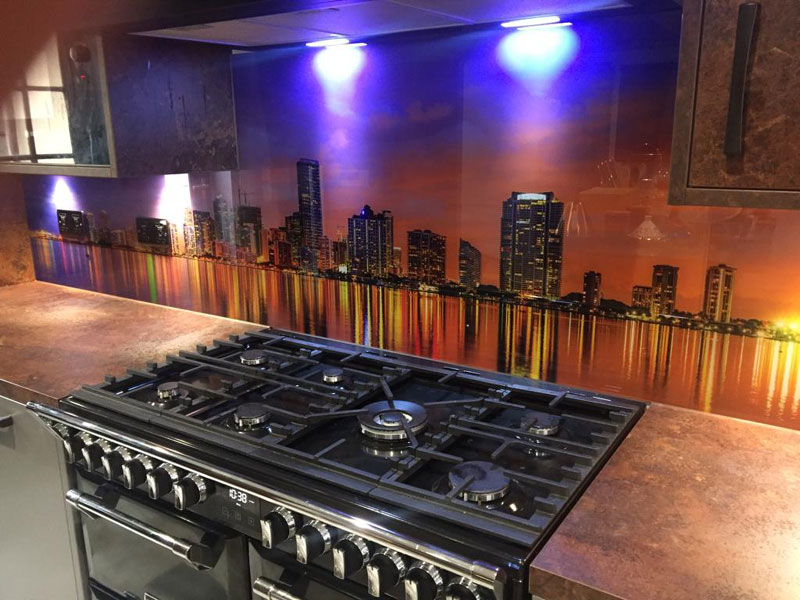
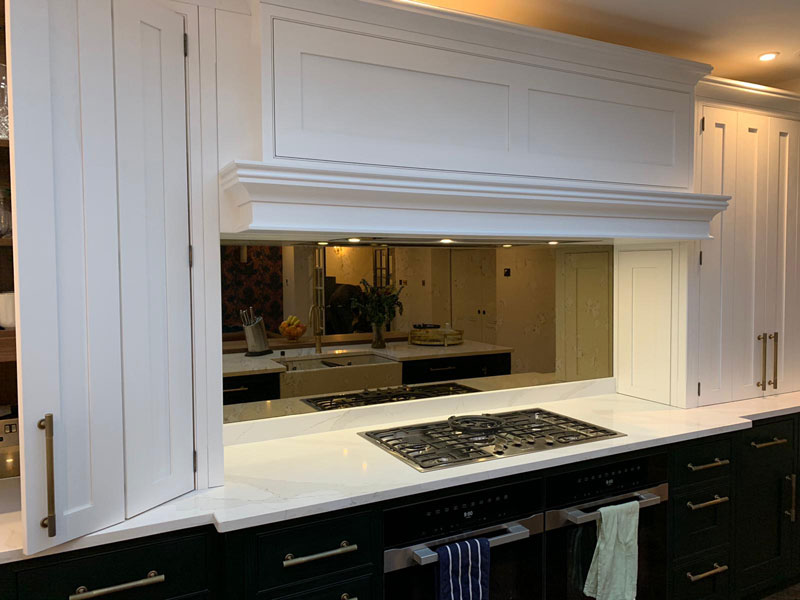
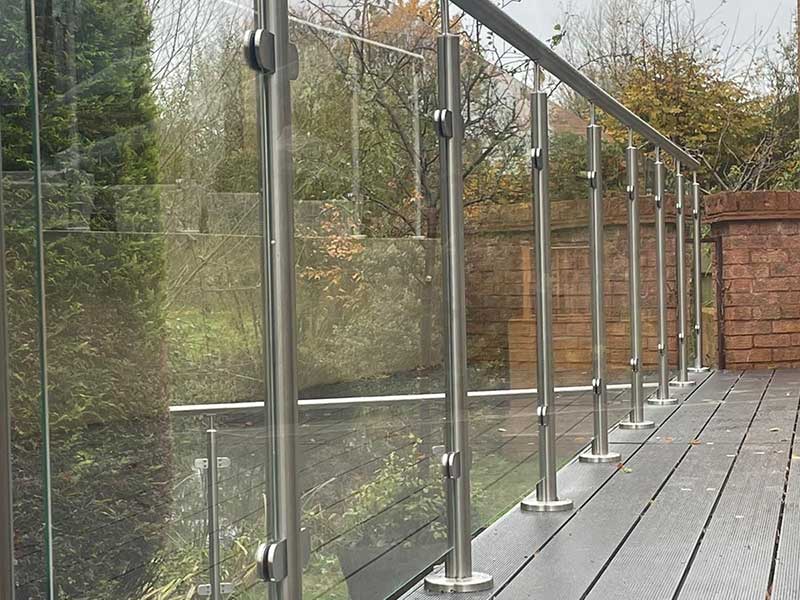
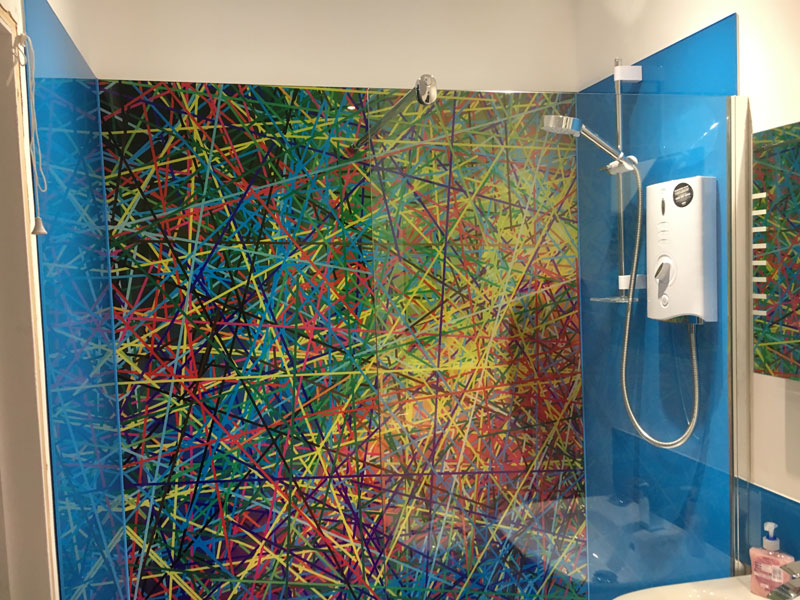
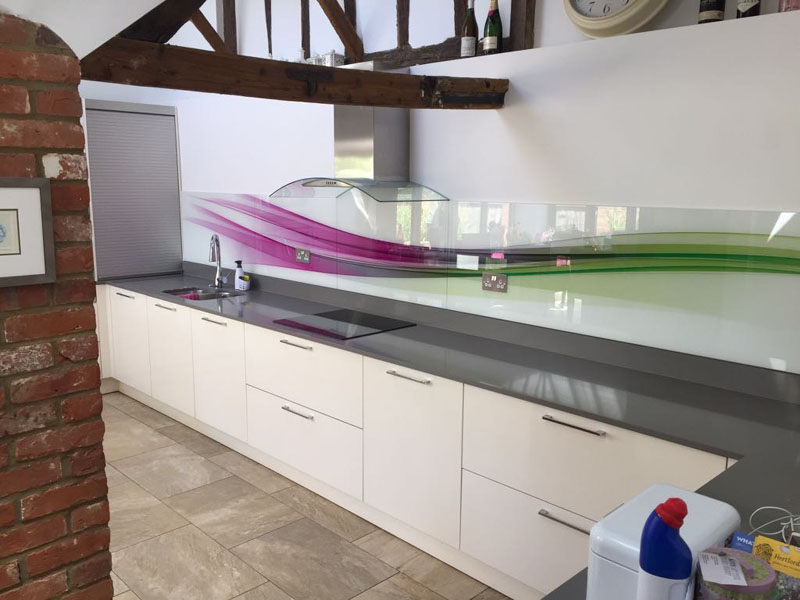
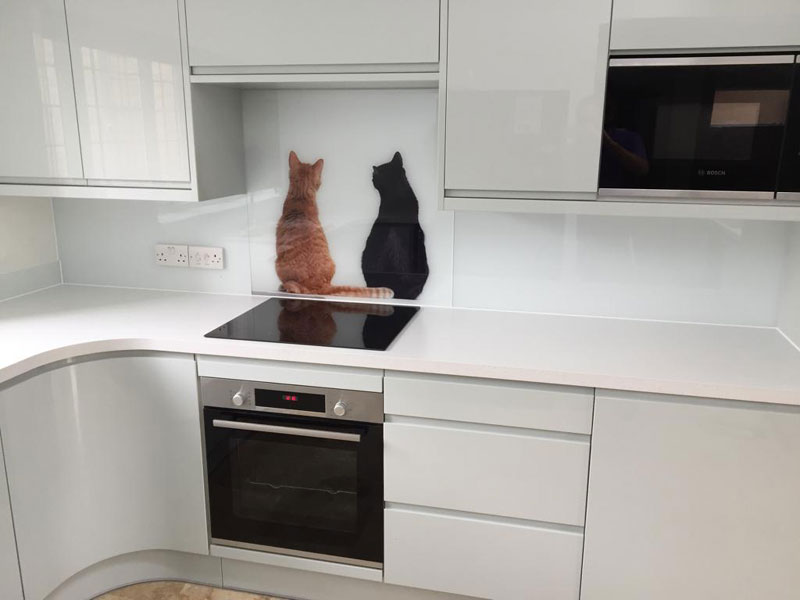
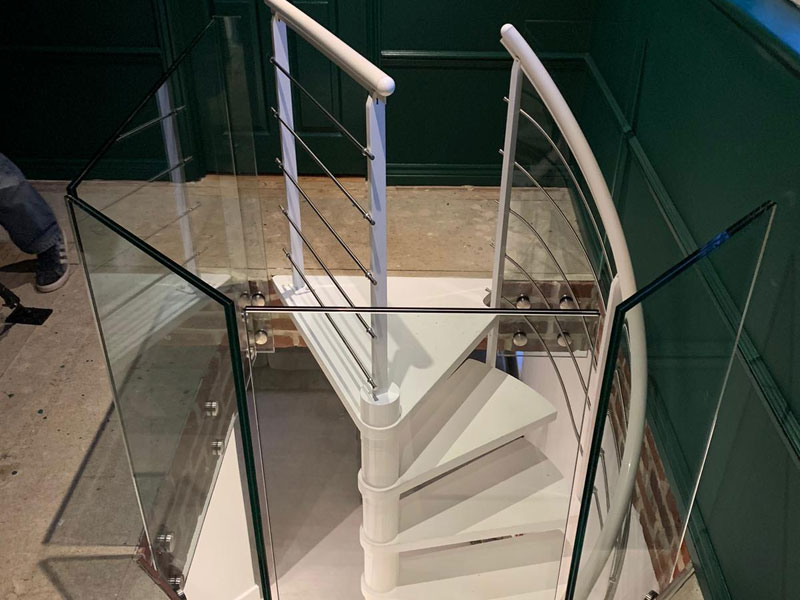
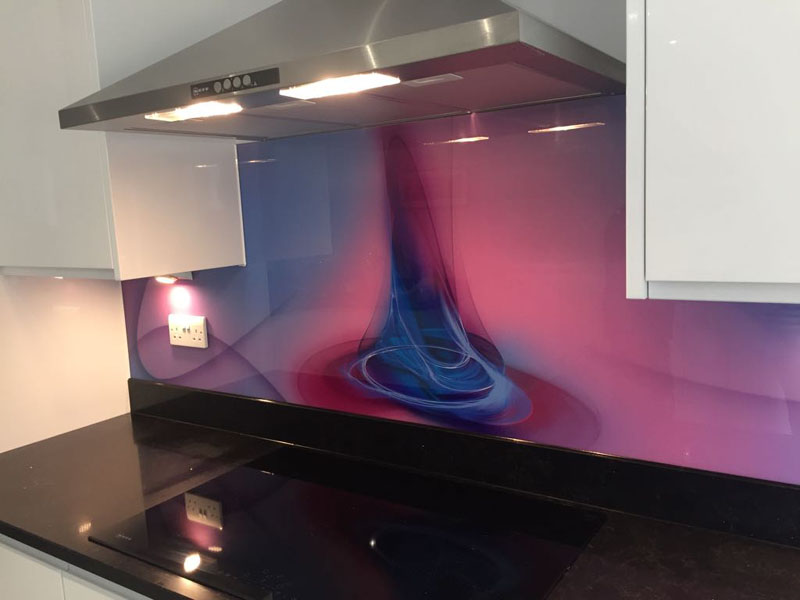
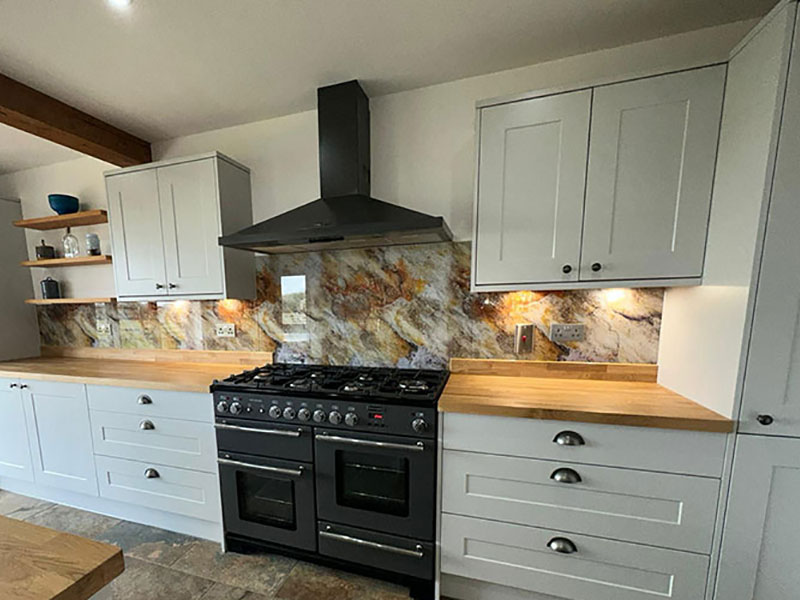
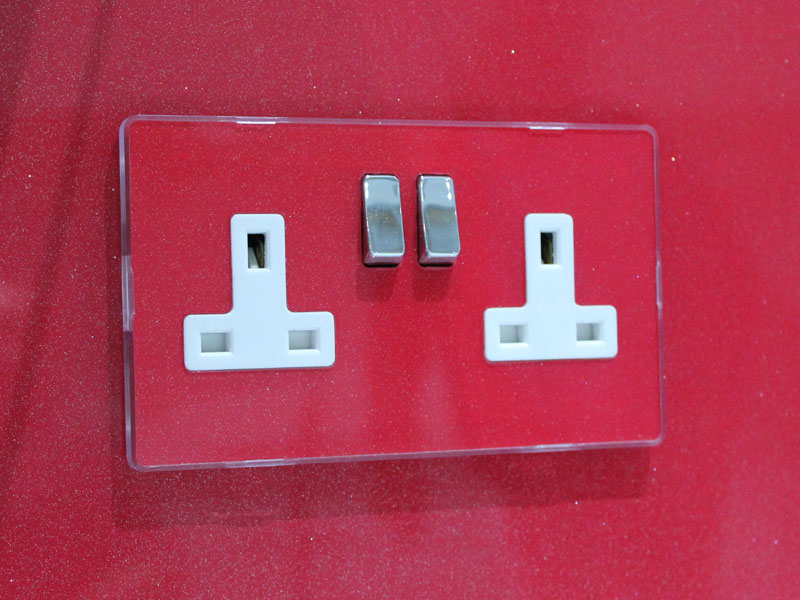


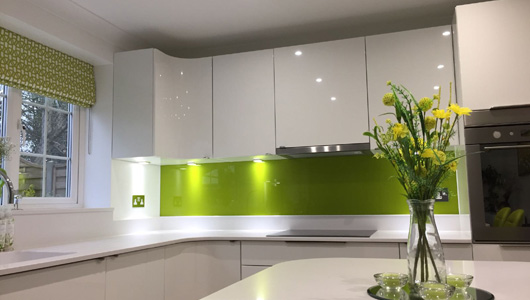
Splashbacks of Distinction
As one of the leaders in design and up to date technology, Splashbacks of Distinction are always on hand to deliver the highest standards of quality and service to our valued customers.
Splashbacks of Distinction provide a wonderful product that is suitable for kitchens, bathrooms, office spaces or anywhere you want a true touch of class.
Our splashbacks will add value and style to new and old kitchens and bathrooms. They are easy to clean and very hygienic. Every piece is toughened when manufactured so it is heat, water and impact proof.
A glass splashback and worktop will complement any bathroom, kitchen, bar area, laundry or shop. The sleek and seamless surface is the ultimate in elegance with zero visual interruption. Our glass splashbacks and worktops come in any colour and are also far easier to clean than ceramic tiles.
Should you require our services, please call or contact us by completing the simple contact form and we will get back to you as soon as possible.
Why not visit our show room or browse through our brochure
The Splashbacks of Distinction show room is located at Watton at Stone in Hertfordshire with easy access from Hertford, Stevenage and surrounding towns. It is close to both the A1 and A10 which makes it easily accessible from North London.
We have a wide range of samples, styles, colours and textures for you to see and touch. Our clients have told us that being able to visit our showroom really helps them to visualise and develop their ideas so that they really end up with exactly what they wanted. Our workshop is next to the showroom so you can also see our products as they are manufactured.
Hertfordshire Showroom Details
We have also created a stunning brochure with a selection from our range. This is available to download as a PDF by clicking on the link below.
Adding class to glass with our glass balustrades
Glass creates an illusion of more space and allows outside features to become part of the interior design. With glass it is possible to link two different spaces together without the barrier of a wall giving you the ability to enjoy your home and garden throughout the year.
Our frameless systems create a contemporary design which safely maximises any view, allowing natural light to spread across the living space. This solution can be used for internal stairs, external balconies, or to act as windbreaks in exposed areas outdoors.
Balustrade posts provide a classic, yet still very popular, design choice. Manufactured using 2.6mm thick walled, 48mm stainless steel for superior strength. This high quality, external grade steel maximises durability and minimises maintenance.
Glass spigots create a modern, minimalist design choice which maximises your view. Glass spigots are a large glass floor clamp that secures the glass vertically. The individual 'feet' allow for natural drainage making it an ideal choice for external areas including patio, and decked gardens, as well as poolside areas.
Massive range of printed splashbacks
The possibilities are almost endless. Whether you wish to modernise your home or office space, enhance it or create an eye-catching element in one of your rooms we are here to make your dream come true. Your wish is our command.
Perhaps a tropical landscape in the bathroom? How about a stylish banister or wall art? Or even a state-of-the art room divider?
If you own a business you might want to create a new inviting atmosphere for your customers or upgrade your existing space, making it uniquely stylish.
At Splashbacks of Distinction we can even recreate different surface patterns too. That wood-style surface you always wanted is now possible and it comes with all the advantages of glass. Our customers also love our granite and marble styles which are perfectly stunning.
NEW range of glass mirrors
When it comes to Mirrors, in either a Kitchen or Bathroom, nothing quite rivals the open, light and clean look that such a simple product offers.
Splashbacks of Distinction offer a range of standard mirrors available in Silver, Grey, Bronze and Peach with toughened options available.
Our bespoke antique mirrors offer depth and character, reflecting the beauty of its surroundings as well as enhancing them. Our collection of six unique mirrors can bring depth, glamour and a unique look to any space.
Choose from our range of antique mirror styles including moon, lava, mercury, Neptune, vincenzo, bronze vincenzo and bianco nero. Why not view our brochure or contact us today to see what we can do for you.
We can supply samples to help you choose
It is often very difficult to see what a particular colour or finish will look like from a picture. We understand that and can supply samples of your chosen splash back to enable you to get the best possible idea of what your dream kitchen or bathroom will look like before it is fitted.
We already have hundreds of samples available to look at in our showroom including different types of finishes such as glitter or sparkle. We can supply a sample in any colour or finish you would like from our extensive range.
Our splash backs are often so vibrant that it is very difficult to really appreciate them from a simple image and with some finishes, such as the mirrored finishes, it is virtually impossible. With a sample you can get a much clearer idea of how your splash back will look in your kitchen and how it will compliment the other colours and textures around it.
A complete service from measuring to final installation
At Splashbacks of Distinction we carefully manage the complete production, design and fitting of our bespoke, designer glass splashbacks.
Great care is taken to measure the intended space and our team will discuss your requirements and help with any ideas you have. Once we have finalised your design with our team, Splashbacks of Distinction can start to make the magic happen.
At every stage of the production process each of our panels is quality checked. Once one of our panels has left our workshop, we at Splashbacks of Distinction transport it and install it. Because each design is unique, it requires specialist knowledge to ensure correct fitting. Our team of experienced fitters will ensure that the panels are correctly aligned and mounted. We won't be happy until our customer is completely happy with the result.
Our team will work closely with you to create your dream design, ensuring the highest quality from start to finish so you can look forward to the magnificent result. We take pride in maintaining the highest of standards so that you, our customer can enjoy the beauty of our bespoke products.
The highest levels of safety and quality as standard
All of our glass splashbacks and panels are made using toughened glass. The glass is processed in accordance with the requirements of the relevant British and European quality standards BS EN 12150 : 2000 (Impact Tested BS EN 12600 : 2000).
You can rest assured that our glass splashbacks are safe and of the highest quality. Splashbacks of Distinction carries out rigorous checks to ensure that each panel is of the highest standard. At Splashbacks of Distinction we make sure that every panel is correctly aligned and fitted. Our toughened glass splashbacks are made to withstand daily use and will provide you with a strong, durable surface whilst maintaining their wonderful appeal and elegance. Reflecting natural light and brightening up dark corners, the splashbacks create an inviting, vibrant atmosphere.
Whether as a wall in a shower, as a room divider or a banister, our toughened glass will not let you down. It provides an excellent sealed barrier in kitchens and bathrooms where steam can cause havoc to walls and plaster.
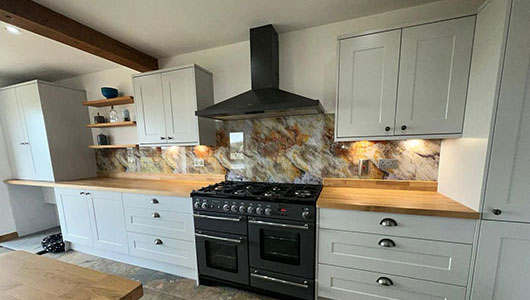
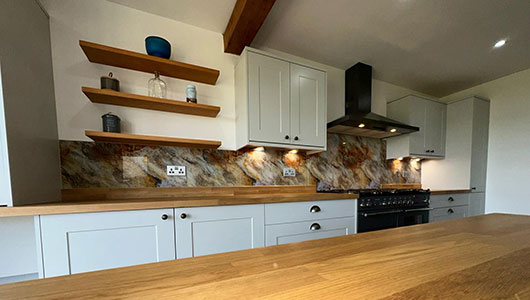
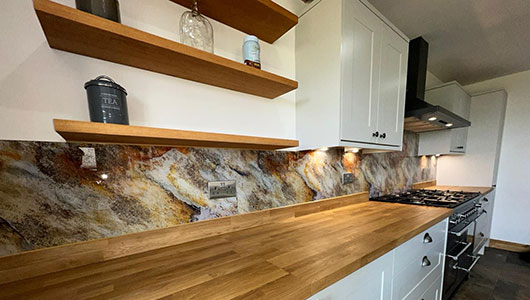
Wonderful customer service
I felt you really cared that we got the best effect for our kitchen and were happy to help us work through the options for as long as it took. Wonderful customer service and the splashback looks great.
(Kitchen splashback using design 010 from our own range)
Mrs Crawford, Aston”
Based in Stevenage, Hertfordshire, Splashbacks of Distinction have a real passion for toughened glass in and around the home. We have transformed many properties, both commercial and domestic with our glass splashbacks, for kitchens, bathrooms and living rooms. Our toughened glass balustrades, glass shelving and splashbacks with high resolution images have really caught the imagination of people who demand beauty and functionality in their homes and offices.
Colchester is a very historic town and the largest settlement within the borough of Colchester in Essex.
At the time of the census in 2001, Colchester had a population of 104,390, marking a considerable rise from the previous census and with considerable development since 2001 and ongoing building plans; it has been named as one of Britains fastest growing towns. As the oldest recorded Roman town in Britain, Colchester is claimed to be the oldest town in Britain. It was for a time the capital of Roman Britain, and is a member of the Most Ancient European Towns Network.
Colchester is 51.2 miles northeast of London and is connected to the capital by the A12 road and the Great Eastern Main Line. It is seen as a popular town for commuters, and is less than 30 miles away from Stansted Airport.
Colchester is home to Colchester Castle and Colchester United Football Club. Colchester has a Liberal Democrat Member of Parliament.
Colchester history: Rich and diverse
Owing to the age of Colchester, it is hardly surprising that the town has such a wealth of history. If times past is of interest to you, Colchester is the place to visit to satisfy your thirst for historical facts about the oldest town in Britain.
Colchester prehistory
The gravel hill upon which Colchester is built was formed in the Middle Pleistocene period, and was shaped into a terrace between the Anglian glaciation and the Ipswichian glaciation by an ancient precursor to the River Colne. From these deposits beneath the town have been found Palaeolithic flint tools, including at least six Acheulian handaxes. Further flint tools made by hunter gatherers living in the Colne Valley during the Mesolithic have been discovered, including a tranchet axe from Middlewick. In the 1980s an archaeological inventory showed that over 800 shards of pottery from the Neolithic, Bronze Age and early Iron Age have been found within Colchester, along with many examples of worked flint. This included a pit found at Culver Street containing a ritually placed Neolithic grooved ware pot, as well as find spots containing later Deverel Rimbury bucket urns. Colchester is surrounded by Neolithic and Bronze Age monuments that pre date the town itself, these include a Neolithic henge at Tendring, large Bronze Age barrow cemeteries at Dedham and Langham, and a larger example at Brightlingsea consisting of a cluster of twenty two barrows.
Celtic origins of Colchester
Colchester is said to be the oldest recorded town in Britain on the grounds that it was mentioned by Pliny the Elder, who died in AD 79, although the Celtic name of the town, Camulodunon appears on coins minted by tribal chieftain Tasciovanus in the period 20 - 10 BC. Before the Roman conquest of Britain it was already a centre of power for Cunobelin, known to Shakespeare as Cymbeline, the king of the Catuvellauni, who minted coins there.
The Celtic name of Colchester, Camulodunon, variously represented as CA, CAM, CAMV, CAMVL and CAMVLODVNO on the coins of Cunobelinus, means the fortress of the war god Camulos. During the 30s AD Camulodunon controlled a large swathe of Southern and Eastern Britain, with Cunobelin called King of the Britons by Roman writers. Camulodunon is sometimes popularly considered one of many possible sites around Britain for the legendary Camelot of King Arthur, though the name Camelot is most likely a corruption of Camlann, a now unknown location first mentioned in the 10th century Welsh annalistic text Annales Cambriae, identified as the place where Arthur was slain in battle.
The Roman period in Colchester
Soon after the Roman conquest of Britain in AD 43, a Roman legionary fortress was established, this was to be the first in Britain. Later, when the Roman frontier moved outwards and the twentieth legion had moved to the west, Camulodunum became a colonia named in a second century inscription as Colonia Victricensis. This contained a large and elaborate Temple to the Divine Emperor Claudius, the largest classical style temple in Britain, as well as at least seven other Romano British temples.
Colchester is home to two of the five Roman theatres found in Britain; the example at Gosbecks is the largest in Britain and is able to seat five thousand.
Camulodunum served as a provincial Roman capital of Britain, but was attacked and destroyed during Boudicas rebellion in AD 61. Sometime after the destruction, London became the capital of the province of Britannia. Colchesters town walls were built, when the Roman town was rebuilt after the Boudicca rebellion. In 2004, Colchester Archaeological Trust discovered the remains of a Roman Circus, used for chariot races, underneath the Garrison in Colchester. The Roman town of Camulodunum, officially known as Colonia Victricensis, reached its peak in the Second and Third centuries AD. It may have reached a population of 30,000 during that period.
In 2014 a hoard of jewellery, known as The Fenwick Hoard, named for the shop it was found beneath, was discovered in Colchester town centre. The director of Colchester Archaeological Trust, described the hoard as being of national importance and one of the finest ever uncovered in Britain.
The medieval period in Colchester
Medieval Colchester still has its main landmark as Colchester Castle. Colchester castle is an 11th century Norman keep, and is built on top of the vaults of the old Roman temple. There are notable medieval ruins in Colchester, including the surviving gateway of the Benedictine abbey of St John the Baptist, and the ruins of the Augustinian priory of St Botolph. Many of Colchesters parish churches date from this period.
Colchesters medieval town seal has incorporated the biblical text Intravit ihc: in quoddam castellum et mulier quedam excepit illum. This translates to Jesus entered a certain castle and a woman there welcomed him. This is a commonplace allegory in which a castle is likened to Marys womb, and explains the name of Maidenburgh St, neighbouring the castle.
In 1189, Colchester was granted its first royal charter by King Richard I. who was probably better known as Richard the Lionheart. The charter was granted at Dover with the king about to embark on one of his many journeys away from England. The borough celebrated the 800th anniversary of its charter in 1989.
Colchester developed rapidly during the later 14th century as a centre of the woollen cloth industry, and became famous in many parts of Europe for its russets, these are fabrics of a grey and brown colour. This allowed the population to recover rapidly from the effects of the Black Death, particularly by immigration into the town. Rovers Tye Farm, now a pub on Ipswich Road, has been documented as being established by 1353.
Colchester in Tudor times
By 1372, a borough council was instituted; the two bailiffs who represented the borough to the king were now expected to consult sixteen ordinary councillors and eight auditors, who were later called aldermen. Even though Colchesters fortunes were more mixed during the 15th century, it was still a more important place by the 16th century than it had been in the 13th. In 1334 it would not have ranked among Englands wealthiest fifty towns, to judge from the taxation levied that year. By 1524, however, it ranked twelfth, as measured by its assessment to a lay subsidy.
Between 1550 and 1600, a large number of weavers and clothmakers from Flanders, the Dutch speaking northern portion of Belgium emigrated to Colchester and the surrounding areas. They were famed for the production of Bays and Says cloths which were woven from wool and are normally associated with Baize and Serge although surviving examples show that they were rather different from their modern equivalents. An area in town centre is still known as the Dutch Quarter and many buildings there date from the Tudor period. During this period Colchester was one of the most prosperous wool towns in England, and was also famed for its oysters.
Flemish refugees in the 1560s brought innovations that revived the local cloth trade, establishing the Dutch Bay Hall for quality control of the textiles for which Colchester became famous. The old Roman wall runs along Northgate Street in the Dutch Quarter.
During the reign of Queen Mary 1st, she earned the name of Bloody Mary, when Colchester became a centre of Protestant heresy and in consequence at least nineteen of the local Colchester people were burned at the stake at the Castle, at first in front, later within the walls. They are commemorated on a tablet near the altar of St Peters Church. Mary was desperate to bring Catholicism back as the prominent religion in Britain after her father King Henry had broken away from the Catholic faith over the refusal of the pope to grant a divorce from Catherine of Aragon, Marys mother. Henry wanted to be free to marry his mistress, Anne Boleyn. When Mary died, her younger half sister Elizabeth took the throne and ended the persecution of the protestants.
Splashbacks of Distinction have been producing and fitting the very finest quality toughened glass splashbacks and other glass related products for a number of years and our reputation is second to none. A large percentage of our work is drawn from referrals from our very satisfied customers. The bulk of our work is in the area of kitchen and bathroom glass splashbacks, although many of our clients are now making enquiries about our other glass products as the splashbacks look and feel so good and are a doddle to keep clean.
Splashbacks of Distinction supply the following splashback products in Colchester, Essex
- Glass kitchen splashbacks
- Glass kitchen splashback samples
- Glass kitchen splashbacks in many different colours
- Printed glass splashbacks
- Colour matched splashbacks
- Painted splashbacks
Splashbacks of Distinction also supply the following glass products in Colchester, Essex
- Stainless steel and glass Balustrades
- Glass shelves
- Coloured mirrors
- Toughened mirrors
- Decorative glass
- Glass hardware
- Glass worktops
- Glass shower cubicle
- Garden glass balustrades
- Glass staircases
- Glass table tops
- Satin glass
- Toughened glass
- Laminated glass
- Opaque glass
Splashbacks of Distinction also supply the following glass related services in Colchester, Essex
- Glass cut to size
- Mirrors cut to size while you wait
- Glass processing
- Glass supply and installation
- Supply only splashbacks
- A glass express service
- Template and fit
Only the finest quality from Splashbacks of Distinction
Splashbacks of Distinction ensure that only the finest quality toughened glass is used in all our products. We guarantee all of our work and are fully insured. We employ only trained and certified engineers. Splashbacks of Distinction never leave your property without ensuring you are totally satisfied with your beautiful new glass splashback, baluster, shelving or shower enclosure.
Further Information
If you would like to know more or are interested in a quote we would be happy to help. Phone us on 01920 830 084, email us at enquiries@splashbacksofdistinction.co.uk or fill in our enquiry form and we will be in touch as soon as possible.
Areas covered in Essex:
- Basildon, Essex - Kitchen splashbacks | Bathroom splashbacks | Splashbacks with High Resolution Pictures | Glass Balustrades | Glass Shelves | Bespoke Mirrors | Bespoke Shower Screens and Enclosures | Acrylic Splashbacks | Glass splashbacks | Glass Worktops
- Billericay, Essex - Kitchen splashbacks | Bathroom splashbacks | Splashbacks with High Resolution Pictures | Glass Balustrades | Glass Shelves | Bespoke Mirrors | Bespoke Shower Screens and Enclosures | Acrylic Splashbacks | Glass splashbacks | Glass Worktops
- Braintree, Essex - Kitchen splashbacks | Bathroom splashbacks | Splashbacks with High Resolution Pictures | Glass Balustrades | Glass Shelves | Bespoke Mirrors | Bespoke Shower Screens and Enclosures | Acrylic Splashbacks | Glass splashbacks | Glass Worktops
- Brentwood, Essex - Kitchen splashbacks | Bathroom splashbacks | Splashbacks with High Resolution Pictures | Glass Balustrades | Glass Shelves | Bespoke Mirrors | Bespoke Shower Screens and Enclosures | Acrylic Splashbacks | Glass splashbacks | Glass Worktops
- Canvey Island, Essex - Kitchen splashbacks | Bathroom splashbacks | Splashbacks with High Resolution Pictures | Glass Balustrades | Glass Shelves | Bespoke Mirrors | Bespoke Shower Screens and Enclosures | Acrylic Splashbacks | Glass splashbacks | Glass Worktops
- Chafford Hundred, Essex - Kitchen splashbacks | Bathroom splashbacks | Splashbacks with High Resolution Pictures | Glass Balustrades | Glass Shelves | Bespoke Mirrors | Bespoke Shower Screens and Enclosures | Acrylic Splashbacks | Glass splashbacks | Glass Worktops
- Chelmsford, Essex - Kitchen splashbacks | Bathroom splashbacks | Splashbacks with High Resolution Pictures | Glass Balustrades | Glass Shelves | Bespoke Mirrors | Bespoke Shower Screens and Enclosures | Acrylic Splashbacks | Glass splashbacks | Glass Worktops
- Chigwell, Essex - Kitchen splashbacks | Bathroom splashbacks | Splashbacks with High Resolution Pictures | Glass Balustrades | Glass Shelves | Bespoke Mirrors | Bespoke Shower Screens and Enclosures | Acrylic Splashbacks | Glass splashbacks | Glass Worktops
- Chipping Ongar, Essex - Kitchen splashbacks | Bathroom splashbacks | Splashbacks with High Resolution Pictures | Glass Balustrades | Glass Shelves | Bespoke Mirrors | Bespoke Shower Screens and Enclosures | Acrylic Splashbacks | Glass splashbacks | Glass Worktops
- Epping, Essex - Kitchen splashbacks | Bathroom splashbacks | Splashbacks with High Resolution Pictures | Glass Balustrades | Glass Shelves | Bespoke Mirrors | Bespoke Shower Screens and Enclosures | Acrylic Splashbacks | Glass splashbacks | Glass Worktops
- Grays, Essex - Kitchen splashbacks | Bathroom splashbacks | Splashbacks with High Resolution Pictures | Glass Balustrades | Glass Shelves | Bespoke Mirrors | Bespoke Shower Screens and Enclosures | Acrylic Splashbacks | Glass splashbacks | Glass Worktops
- Great Dunmow, Essex - Kitchen splashbacks | Bathroom splashbacks | Splashbacks with High Resolution Pictures | Glass Balustrades | Glass Shelves | Bespoke Mirrors | Bespoke Shower Screens and Enclosures | Acrylic Splashbacks | Glass splashbacks | Glass Worktops
- Halstead, Essex - Kitchen splashbacks | Bathroom splashbacks | Splashbacks with High Resolution Pictures | Glass Balustrades | Glass Shelves | Bespoke Mirrors | Bespoke Shower Screens and Enclosures | Acrylic Splashbacks | Glass splashbacks | Glass Worktops
- Harlow, Essex - Kitchen splashbacks | Bathroom splashbacks | Splashbacks with High Resolution Pictures | Glass Balustrades | Glass Shelves | Bespoke Mirrors | Bespoke Shower Screens and Enclosures | Acrylic Splashbacks | Glass splashbacks | Glass Worktops
- Harwich, Essex - Kitchen splashbacks | Bathroom splashbacks | Splashbacks with High Resolution Pictures | Glass Balustrades | Glass Shelves | Bespoke Mirrors | Bespoke Shower Screens and Enclosures | Acrylic Splashbacks | Glass splashbacks | Glass Worktops
- Ingatestone, Essex - Kitchen splashbacks | Bathroom splashbacks | Splashbacks with High Resolution Pictures | Glass Balustrades | Glass Shelves | Bespoke Mirrors | Bespoke Shower Screens and Enclosures | Acrylic Splashbacks | Glass splashbacks | Glass Worktops
- Leigh On Sea, Essex - Kitchen splashbacks | Bathroom splashbacks | Splashbacks with High Resolution Pictures | Glass Balustrades | Glass Shelves | Bespoke Mirrors | Bespoke Shower Screens and Enclosures | Acrylic Splashbacks | Glass splashbacks | Glass Worktops
- Loughton, Essex - Kitchen splashbacks | Bathroom splashbacks | Splashbacks with High Resolution Pictures | Glass Balustrades | Glass Shelves | Bespoke Mirrors | Bespoke Shower Screens and Enclosures | Acrylic Splashbacks | Glass splashbacks | Glass Worktops
- Maldon, Essex - Kitchen splashbacks | Bathroom splashbacks | Splashbacks with High Resolution Pictures | Glass Balustrades | Glass Shelves | Bespoke Mirrors | Bespoke Shower Screens and Enclosures | Acrylic Splashbacks | Glass splashbacks | Glass Worktops
- Rayleigh, Essex - Kitchen splashbacks | Bathroom splashbacks | Splashbacks with High Resolution Pictures | Glass Balustrades | Glass Shelves | Bespoke Mirrors | Bespoke Shower Screens and Enclosures | Acrylic Splashbacks | Glass splashbacks | Glass Worktops
- Southend On Sea, Essex - Kitchen splashbacks | Bathroom splashbacks | Splashbacks with High Resolution Pictures | Glass Balustrades | Glass Shelves | Bespoke Mirrors | Bespoke Shower Screens and Enclosures | Acrylic Splashbacks | Glass splashbacks | Glass Worktops
- Saffron Waldon, Essex - Kitchen splashbacks | Bathroom splashbacks | Splashbacks with High Resolution Pictures | Glass Balustrades | Glass Shelves | Bespoke Mirrors | Bespoke Shower Screens and Enclosures | Acrylic Splashbacks | Glass splashbacks | Glass Worktops
- Stanford Le Hope, Essex - Kitchen splashbacks | Bathroom splashbacks | Splashbacks with High Resolution Pictures | Glass Balustrades | Glass Shelves | Bespoke Mirrors | Bespoke Shower Screens and Enclosures | Acrylic Splashbacks | Glass splashbacks | Glass Worktops
- Tilbury, Essex - Kitchen splashbacks | Bathroom splashbacks | Splashbacks with High Resolution Pictures | Glass Balustrades | Glass Shelves | Bespoke Mirrors | Bespoke Shower Screens and Enclosures | Acrylic Splashbacks | Glass splashbacks | Glass Worktops
- Waltham Abbey, Essex - Kitchen splashbacks | Bathroom splashbacks | Splashbacks with High Resolution Pictures | Glass Balustrades | Glass Shelves | Bespoke Mirrors | Bespoke Shower Screens and Enclosures | Acrylic Splashbacks | Glass splashbacks | Glass Worktops
- West Mersea, Essex - Kitchen splashbacks | Bathroom splashbacks | Splashbacks with High Resolution Pictures | Glass Balustrades | Glass Shelves | Bespoke Mirrors | Bespoke Shower Screens and Enclosures | Acrylic Splashbacks | Glass splashbacks | Glass Worktops
- West Thurrock, Essex - Kitchen splashbacks | Bathroom splashbacks | Splashbacks with High Resolution Pictures | Glass Balustrades | Glass Shelves | Bespoke Mirrors | Bespoke Shower Screens and Enclosures | Acrylic Splashbacks | Glass splashbacks | Glass Worktops
- Wickford, Essex - Kitchen splashbacks | Bathroom splashbacks | Splashbacks with High Resolution Pictures | Glass Balustrades | Glass Shelves | Bespoke Mirrors | Bespoke Shower Screens and Enclosures | Acrylic Splashbacks | Glass splashbacks | Glass Worktops

Showroom: Unit 11, Broomhall Farm, Watton At Stone, Hertford SG14 2RN
Splashbacks of Distinction is the trading name of RDC Glass Ltd









